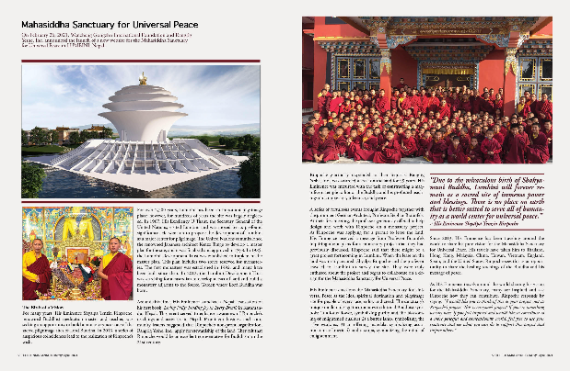
The Birth of a Vision
For many years, His Eminence Shvalpa Tenzin Rinpoche, renowned Buddhist meditation master and teacher, was seeking an opportunity to build a monastery near one of the sacred pilgrimage sites of Lord Buddha. In 2013, a series of auspicious coincidences lead to the realization of Rinpoche’s wish.
For over 2,500 years, Lumbini has been an important pilgrimage place; however, for hundreds of years the site was largely neglected. In 1967, His Excellency U Thant, the Secretary General of the United Nations, visited Lumbini and was moved by its profound significance. He went on to propose the development of Lumbini as a major center for pilgrimage. The United Nations commissioned the renowned Japanese architect Kenzo Tange to develop a master plan for the site, and it was finalized and approved in 1978.
 In 1985, the Lumbini Development Trust was established to implement the master plan. This plan includes two zones reserved for monasteries. The first monastery was established in 1992, and many have been built since then. In 2012, the Lumbini Development Trust was searching for a custodian to develop a tract of land and build a monastery adjacent to the Sacred Garden where Lord Buddha was born.
In 1985, the Lumbini Development Trust was established to implement the master plan. This plan includes two zones reserved for monasteries. The first monastery was established in 1992, and many have been built since then. In 2012, the Lumbini Development Trust was searching for a custodian to develop a tract of land and build a monastery adjacent to the Sacred Garden where Lord Buddha was born.
Around this time, His Eminence launched a Nepali translation of his first book, Living Fully: Finding Joy in Every Breath in Kathmandu, Nepal. This event served to enhance awareness of Rinpoches teachings and activities in Nepal. Prominent business and community leaders suggested that Rinpoches non-profit organization, Rangrig Yeshe, Inc., apply for stewardship of the land. They felt that Rinpoche would be an excellent representative for Buddhism in the 21st century.
Rinpoche graciously responded to their requests. Rangrig Yeshe, Inc., was awarded a lease on the land for 99 years. His Eminence was entrusted with the task of constructing a magnificent temple to honor the Buddha and his profound teachings on compassion, tolerance, and peace.
A series of fortuitous events brought Rinpoche together with the prominent German Architect, Professor Stephan Braunfels. At their first meeting, the professor generously offered to help design and work with Rinpoche on a monastery project. As Rinpoche was applying for a permit to lease the land, His Eminence received a message from Professor Braunfels inquiring about plans for a monastery project that they had previously discussed. Rinpoche said that there might be a great project forthcoming in Lumbini. When the lease on the land was nearly secured, Shyalpa Rinpoche and the professor traveled to Lumbini to survey the site. They were truly enthused about the project and began to collaborate on a design for the Mahasiddha Sanctuary for Universal Peace.
His Eminence envisions the Mahasiddha Sanctuary for Universal Peace as the ideal spiritual destination and pilgrimage site for people of every race, color, and creed. The sanctuary’s unique modern design incorporates traditional Buddhist symbols: 1) a lotus flower, symbolizing purity and the blossoming of enlightened qualities 2) a butter lamp, symbolizing the five wisdoms, 3) an offering mandala, symbolizing accumulation of merit 4) and a stupa, symbolizing the mind of enlightenment.
“Due to the miraculous birth of Shakyamuni Buddha, Lumbini will forever remain as a sacred site of immense power and blessings. There is no place on earth that is better suited to serve all of humanity as a world center for universal peace. ”
- His Eminence Shyalpa Tenzin Rinpoche
Since 2013, His Eminence has been traveling around the world to share his pure vision for the Mahasiddha Sanctuary for Universal Peace. His travels have taken him to Thailand, Hong Kong, Malaysia, China, Taiwan, Vietnam, England, Spain, and the United States. Rinpoche sees this as an opportunity to share the healing teachings of the Buddha and his message of peace.
As His Eminence travels around the world sharing his vision for the Mahasiddha Sanctuary, many are inspired and ask Rinpoche how they can contribute. Rinpoche responds by saying: "I would like you to think of this as your project, not as Rinpoche’s project. This is everyone’s project! If you see something worthy here, if you feel inspired and would like to contribute to a more peaceful and compassionate world feel free to use your creativity and see what you can do to support this project and inspire others. ”